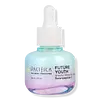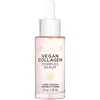What's inside
What's inside
 Key Ingredients
Key Ingredients

 Benefits
Benefits

 Concerns
Concerns

 Ingredients Side-by-side
Ingredients Side-by-side

Water
Skin ConditioningGlycerin
HumectantBeta-Glucan
Skin ConditioningLeuconostoc/Radish Root Ferment Filtrate
AntimicrobialPhaseolus Angularis Seed Extract
AntioxidantAcetyl Hexapeptide-8
HumectantPalmitoyl Tripeptide-5
Skin ConditioningTrifluoroacetyl Tripeptide-2
Skin ConditioningSh-Polypeptide-50
Skin ConditioningCaprooyl Tetrapeptide-3
Skin ProtectingHydrolyzed Jojoba Esters
Skin ConditioningHydroxyethylcellulose
Emulsion StabilisingSorbitan Oleate Decylglucoside Crosspolymer
CleansingAloe Barbadensis Leaf Juice
Skin ConditioningLeontopodium Alpinum Flower/Leaf Extract
Skin ConditioningFragaria Ananassa Seed Oil
AntioxidantAcetic Acid
BufferingXanthan Gum
EmulsifyingBiosaccharide Gum-1
HumectantAlgin
MaskingDextran
Potassium Sorbate
PreservativeSodium Hyaluronate
HumectantSaccharomyces/Xylinum/Black Tea Ferment
Skin ConditioningVanilla Planifolia Fruit Extract
Skin ConditioningCucumis Sativus Extract
Skin ConditioningPassiflora Incarnata Flower Extract
Skin ConditioningPaeonia Albiflora Root Extract
Skin ConditioningOryza Sativa Extract
AbsorbentSaccharomyces Lysate
Skin ConditioningMalpighia Glabra Fruit
Skin ConditioningCitric Acid
BufferingPhenoxyethanol
PreservativeEthylhexylglycerin
Skin ConditioningEctoin
Skin ConditioningCamellia Oleifera Seed Oil
Skin ConditioningParfum
MaskingWater, Glycerin, Beta-Glucan, Leuconostoc/Radish Root Ferment Filtrate, Phaseolus Angularis Seed Extract, Acetyl Hexapeptide-8, Palmitoyl Tripeptide-5, Trifluoroacetyl Tripeptide-2, Sh-Polypeptide-50, Caprooyl Tetrapeptide-3, Hydrolyzed Jojoba Esters, Hydroxyethylcellulose, Sorbitan Oleate Decylglucoside Crosspolymer, Aloe Barbadensis Leaf Juice, Leontopodium Alpinum Flower/Leaf Extract, Fragaria Ananassa Seed Oil, Acetic Acid, Xanthan Gum, Biosaccharide Gum-1, Algin, Dextran, Potassium Sorbate, Sodium Hyaluronate, Saccharomyces/Xylinum/Black Tea Ferment, Vanilla Planifolia Fruit Extract, Cucumis Sativus Extract, Passiflora Incarnata Flower Extract, Paeonia Albiflora Root Extract, Oryza Sativa Extract, Saccharomyces Lysate, Malpighia Glabra Fruit, Citric Acid, Phenoxyethanol, Ethylhexylglycerin, Ectoin, Camellia Oleifera Seed Oil, Parfum
Water
Skin ConditioningGlycerin
HumectantCaprylic/Capric Triglyceride
MaskingGlyceryl Oleate Citrate
EmulsifyingSqualane
EmollientAloe Barbadensis Leaf Juice
Skin ConditioningCamellia Japonica Seed Oil
EmollientSr-Hydrozoan Polypeptide-1
HumectantAhnfeltiopsis Concinna Extract
Skin ConditioningChamomilla Recutita Flower Extract
MaskingCitrus Aurantium Dulcis Flower Extract
Skin ConditioningJasminum Officinale Flower Extract
MaskingLeuconostoc/Radish Root Ferment Filtrate
AntimicrobialArnica Montana Flower Extract
MaskingHydrolyzed Jojoba Esters
Skin ConditioningSodium Hyaluronate
HumectantLecithin
EmollientPullulan
Hydrogenated Lecithin
EmulsifyingSilica
AbrasiveCaprylyl/Capryl Glucoside
CleansingXanthan Gum
EmulsifyingSclerotium Gum
Emulsion StabilisingCetearyl Alcohol
EmollientMaltodextrin
AbsorbentGlucose
HumectantCitric Acid
BufferingPotassium Sorbate
PreservativeEthylhexylglycerin
Skin ConditioningSodium Benzoate
MaskingPhenoxyethanol
PreservativeParfum
MaskingWater, Glycerin, Caprylic/Capric Triglyceride, Glyceryl Oleate Citrate, Squalane, Aloe Barbadensis Leaf Juice, Camellia Japonica Seed Oil, Sr-Hydrozoan Polypeptide-1, Ahnfeltiopsis Concinna Extract, Chamomilla Recutita Flower Extract, Citrus Aurantium Dulcis Flower Extract, Jasminum Officinale Flower Extract, Leuconostoc/Radish Root Ferment Filtrate, Arnica Montana Flower Extract, Hydrolyzed Jojoba Esters, Sodium Hyaluronate, Lecithin, Pullulan, Hydrogenated Lecithin, Silica, Caprylyl/Capryl Glucoside, Xanthan Gum, Sclerotium Gum, Cetearyl Alcohol, Maltodextrin, Glucose, Citric Acid, Potassium Sorbate, Ethylhexylglycerin, Sodium Benzoate, Phenoxyethanol, Parfum
 Reviews
Reviews

Ingredients Explained
These ingredients are found in both products.
Ingredients higher up in an ingredient list are typically present in a larger amount.
Aloe Barbadensis Leaf Juice comes from leaves of the aloe plant. Aloe Barbadensis Leaf Juice is best known for helping to soothe sunburns. It is also anti-inflammatory, moisturizing, antiseptic, and can help heal wounds.
Aloe is packed with good stuff including Vitamins A, C, and E. These vitamins are antioxidants, which help fight free-radicals and the damage they may cause. Free-radicals are molecules that may damage your skin cells, such as pollution.
Aloe Barbadensis Leaf Juice also contains sugars. These sugars come in the form of monosaccharides and polysaccharides, folic acid, and choline. These sugars are able to help bind moisture to skin.
It also contains minerals such as calcium, 12 anthraquinones, fatty acids, amino acids, and Vitamin B12.
Learn more about Aloe Barbadensis Leaf JuiceCitric Acid is an alpha hydroxy acid (AHA) naturally found in citrus fruits like oranges, lemons, and limes.
Like other AHAs, citric acid can exfoliate skin by breaking down the bonds that hold dead skin cells together. This helps reveal smoother and brighter skin underneath.
However, this exfoliating effect only happens at high concentrations (20%) which can be hard to find in cosmetic products.
Due to this, citric acid is usually included in small amounts as a pH adjuster. This helps keep products slightly more acidic and compatible with skin's natural pH.
In skincare formulas, citric acid can:
While it can provide some skin benefits, research shows lactic acid and glycolic acid are generally more effective and less irritating exfoliants.
Most citric acid used in skincare today is made by fermenting sugars (usually from molasses). This synthetic version is identical to the natural citrus form but easier to stabilize and use in formulations.
Read more about some other popular AHA's here:
Learn more about Citric AcidEthylhexylglycerin (we can't pronounce this either) is commonly used as a preservative and skin softener. It is derived from glyceryl.
You might see Ethylhexylglycerin often paired with other preservatives such as phenoxyethanol. Ethylhexylglycerin has been found to increase the effectiveness of these other preservatives.
Glycerin is already naturally found in your skin. It helps moisturize and protect your skin.
A study from 2016 found glycerin to be more effective as a humectant than AHAs and hyaluronic acid.
As a humectant, it helps the skin stay hydrated by pulling moisture to your skin. The low molecular weight of glycerin allows it to pull moisture into the deeper layers of your skin.
Hydrated skin improves your skin barrier; Your skin barrier helps protect against irritants and bacteria.
Glycerin has also been found to have antimicrobial and antiviral properties. Due to these properties, glycerin is often used in wound and burn treatments.
In cosmetics, glycerin is usually derived from plants such as soybean or palm. However, it can also be sourced from animals, such as tallow or animal fat.
This ingredient is organic, colorless, odorless, and non-toxic.
Glycerin is the name for this ingredient in American English. British English uses Glycerol/Glycerine.
Learn more about GlycerinThis ingredient is created by cleaving jojoba oil to remove all fatty acids, fatty alcohols, and wax esters.
Hydrolyzed Jojoba Esters has emollient, stabilizing, and hair-conditioning properties.
Leuconostoc/Radish Root Ferment Filtrate is a natural preservative. It comes from fermenting radish roots with a bacteria called leuconostoc.
Leuconostoc comes from lactic acid.
This ingredient has antimicrobial properties and helps prevent the growth of bacteria in a product.
Leuconostoc is used to make the traditional Korean side-dish, kimchi. It is also used to make sourdough bread (both incredibly yummy foods).
Learn more about Leuconostoc/Radish Root Ferment FiltrateParfum is a catch-all term for an ingredient or more that is used to give a scent to products.
Also called "fragrance", this ingredient can be a blend of hundreds of chemicals or plant oils. This means every product with "fragrance" or "parfum" in the ingredients list is a different mixture.
For instance, Habanolide is a proprietary trade name for a specific aroma chemical. When used as a fragrance ingredient in cosmetics, most aroma chemicals fall under the broad labeling category of “FRAGRANCE” or “PARFUM” according to EU and US regulations.
The term 'parfum' or 'fragrance' is not regulated in many countries. In many cases, it is up to the brand to define this term.
For instance, many brands choose to label themselves as "fragrance-free" because they are not using synthetic fragrances. However, their products may still contain ingredients such as essential oils that are considered a fragrance by INCI standards.
One example is Calendula flower extract. Calendula is an essential oil that still imparts a scent or 'fragrance'.
Depending on the blend, the ingredients in the mixture can cause allergies and sensitivities on the skin. Some ingredients that are known EU allergens include linalool and citronellol.
Parfum can also be used to mask or cover an unpleasant scent.
The bottom line is: not all fragrances/parfum/ingredients are created equally. If you are worried about fragrances, we recommend taking a closer look at an ingredient. And of course, we always recommend speaking with a professional.
Learn more about ParfumPhenoxyethanol is a preservative that has germicide, antimicrobial, and aromatic properties. Studies show that phenoxyethanol can prevent microbial growth. By itself, it has a scent that is similar to that of a rose.
It's often used in formulations along with Caprylyl Glycol to preserve the shelf life of products.
Potassium Sorbate is a preservative used to prevent yeast and mold in products. It is commonly found in both cosmetic and food products.
This ingredient comes from potassium salt derived from sorbic acid. Sorbic acid is a natural antibiotic and effective against fungus.
Both potassium sorbate and sorbic acid can be found in baked goods, cheeses, dried meats, dried fruit, ice cream, pickles, wine, yogurt, and more.
You'll often find this ingredient used with other preservatives.
Learn more about Potassium SorbateSodium Hyaluronate is hyaluronic acid's salt form. It is commonly derived from the sodium salt of hyaluronic acid.
Like hyaluronic acid, it is great at holding water and acts as a humectant. This makes it a great skin hydrating ingredient.
Sodium Hyaluronate is naturally occurring in our bodies and is mostly found in eye fluid and joints.
These are some other common types of Hyaluronic Acid:
Learn more about Sodium HyaluronateWater. It's the most common cosmetic ingredient of all. You'll usually see it at the top of ingredient lists, meaning that it makes up the largest part of the product.
So why is it so popular? Water most often acts as a solvent - this means that it helps dissolve other ingredients into the formulation.
You'll also recognize water as that liquid we all need to stay alive. If you see this, drink a glass of water. Stay hydrated!
Learn more about WaterXanthan gum is used as a stabilizer and thickener within cosmetic products. It helps give products a sticky, thick feeling - preventing them from being too runny.
On the technical side of things, xanthan gum is a polysaccharide - a combination consisting of multiple sugar molecules bonded together.
Xanthan gum is a pretty common and great ingredient. It is a natural, non-toxic, non-irritating ingredient that is also commonly used in food products.
Learn more about Xanthan Gum